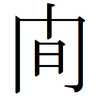間
| ||||||||
Translingual
| Stroke order | |||
|---|---|---|---|
 | |||
Han character
間 (radical 169, 門+4, 12 strokes, cangjie input 日弓日 (ANA), four-corner 77607, composition ⿵門日)
Derived characters
Related characters
References
- KangXi: page 1333, character 1
- Dai Kanwa Jiten: character 41249
- Dae Jaweon: page 1839, character 1
- Hanyu Da Zidian: volume 7, page 4288, character 6
- Unihan data for U+9593
Chinese
| trad. | 間 | |
|---|---|---|
| simp. | 间 | |
| variant forms | 閒 | |
Glyph origin
| Historical forms of the character 間 | ||
|---|---|---|
| Western Zhou | Shuowen Jiezi (compiled in Han) | Liushutong (compiled in Ming) |
| Bronze inscriptions | Small seal script | Transcribed ancient scripts |
 |
 |
 |
| Characters in the same phonetic series (閒) (Zhengzhang, 2003) | |
|---|---|
| Old Chinese | |
| 間 | *kreːn, *kreːns |
| 簡 | *kreːnʔ |
| 澗 | *kreːns, *kraːns |
| 鐧 | *kreːns, *kraːns |
| 蕑 | *kreːn |
| 覵 | *kreːn, *kreːns, *pkrenʔ |
| 襉 | *kreːnʔ, *kreːns |
| 僩 | *kreːnʔ, *ɡraːnʔ |
| 鬜 | *kʰreːn, *kʰraːn, *kʰreːd |
| 癇 | *ɡreːn |
| 瞯 | *ɡreːn |
| 憪 | *ɡreːn, *ɡraːnʔ |
| 橌 | *ɡraːnʔ |
| 撊 | *ɡraːnʔ |
Ideogrammic compound (會意) : 門 (“door”) + 日 (“sun”). Originally 閒, moonlight peeking through a door – interstice; space.
Etymology
The two pronunciations are related, with Pronunciation 2 being the exoactive of Pronunciation 1.
Related to:
- 隙 (OC *kʰraɡ, “crack; chink”), 澗 (OC *kreːns, *kraːns, “ravine; brook (between mountains)”) (Wang, 1982);
- 閒 (OC *ɡreːn, “lazy; leisure”) (Karlgren, 1957; Baxter, 1992).
Externally, likely related to Mizo kâr (“space between; interval”), Burmese ကြား (kra:, “in-between; interval; interim”), အကြား (a.kra:, “gap; break”) (Schuessler, 2007).
Pronunciation 1
Definitions
間
- within a definite time period or place
- among; between
- a moment; a little while; instant
- room; chamber
- section of a room; lateral space between two pairs of pillars
- Classifier for smallest units of housing, such as rooms and shopfronts.
- (chiefly Cantonese) Classifier for buildings in general, including schools, banks, cinemas, hospitals, shops, factories.
- A surname.
Compounds
Derived terms from 間
|
|
|
Pronunciation 2
Definitions
間
- opening; gap; break
- estrangement; alienation; hostility
- spy; secret agent
- to keep away from; to keep apart
- to separate; to partition
- to alternate; to do something alternately
- to be mixed up with; to be intermingled
- to sow discord
- to blame; to reproach
- intermittently; sometimes
- in secret; clandestinely
Compounds
Derived terms from 間
Pronunciation 3
Definitions
間
- † Variant pronunciation of the classifier sense.
- † Used in place names.
Further reading
- “Entry #9175”, in 臺灣閩南語常用詞辭典 [Dictionary of Frequently-Used Taiwan Minnan] (in Chinese and Min Nan), Ministry of Education, R.O.C., 2011.
Japanese
Readings
References
|
- Source: EDICT and KANJIDIC files licensed by the Electronic Dictionaries Research Group.
Etymology 1
| Kanji in this term |
|---|
| 間 |
| あいだ Grade: 2 |
| kun’yomi |
| For pronunciation and definitions of 間 – see the following entry at あいだ. |
| (This term, 間, is a kanji spelling of あいだ.) |
Etymology 2
| Kanji in this term |
|---|
| 間 |
| ま Grade: 2 |
| kun’yomi |
| For pronunciation and definitions of 間 – see the following entry at ま. |
| (This term, 間, is a kanji spelling of ま.) |
Etymology 3
| Kanji in this term |
|---|
| 間 |
| あい Grade: 2 |
| kun’yomi |
| For pronunciation and definitions of 間 – see the following entry at あい. |
| (This term, 間, is a kanji spelling of あい.) |
Suffix
- suffixes some expressions of time to tell duration rather than time or date
- 二時
- ni-ji
- two (o'clock)
- 二時間
- ni-jikan
- two hours
- 二時五分
- ni-ji go-fun
- five past two
- 五分(間)
- go-fun(kan)
- five minutes
- 二日
- futsuka
- the 2nd (day of the month)
- 二日(間)
- futsuka(kan)
- two days
- 二時
Vietnamese
Han character
間: Hán Nôm readings: gian, dán, gián
- This term needs a translation to English. Please help out and add a translation, then remove the text
{{rfdef}}.
References
This article is issued from
Wiktionary.
The text is licensed under Creative
Commons - Attribution - Sharealike.
Additional terms may apply for the media files.
